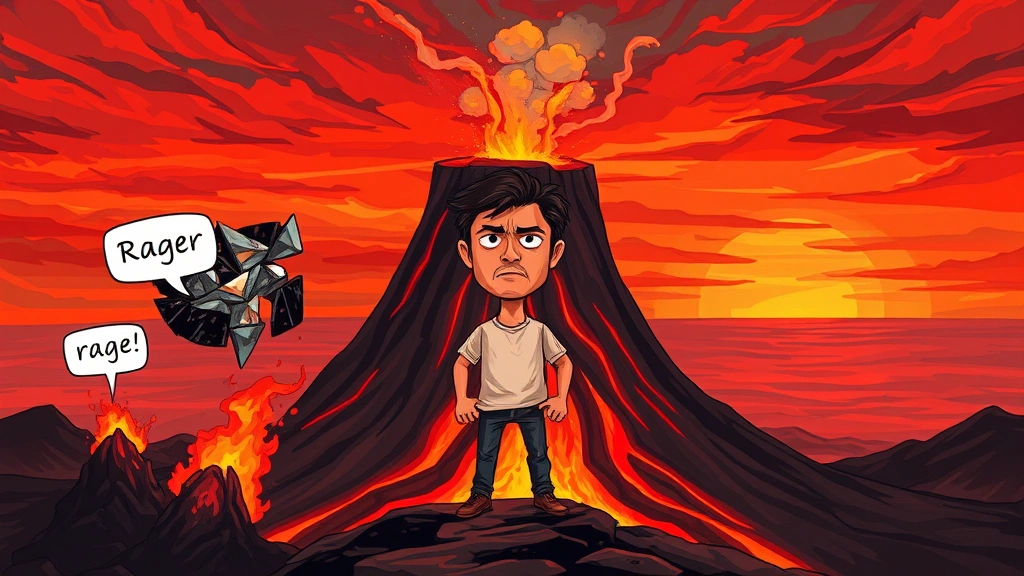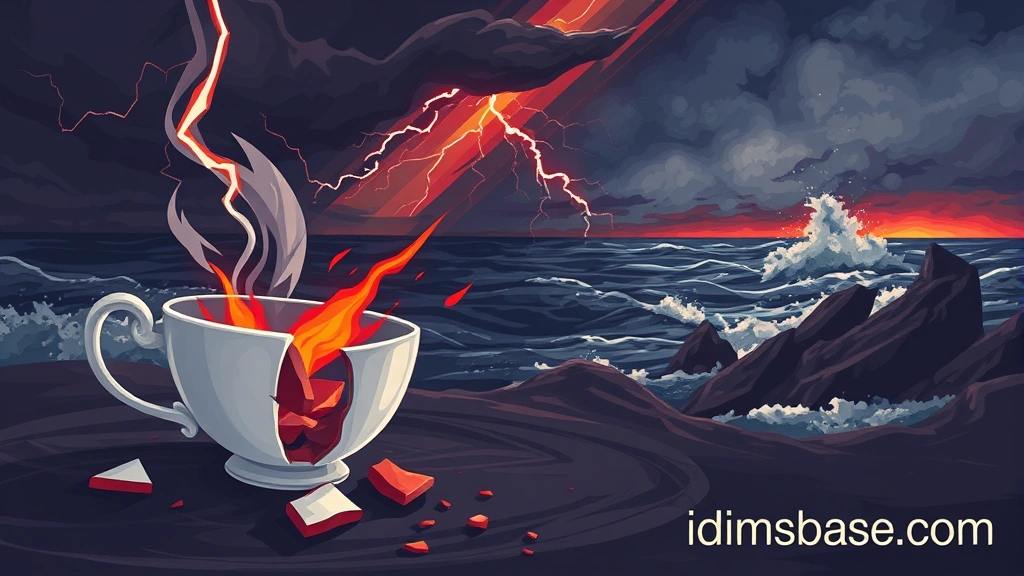Hey there, ever felt a simmering rage building inside you, like a volcano about to erupt? Or perhaps a sudden, fiery outburst that burns everything in its path? Anger, that powerful and often misunderstood emotion, is something we all experience. But how do we talk about it? How do we truly grasp its many forms and intensities? That's where metaphors come in! They're like little linguistic superpowers that help us paint vivid pictures with words, turning abstract feelings into tangible concepts.
Metaphors for anger are fascinating because they reveal how we perceive and process this complex emotion across cultures and personal experiences. They give us a common language to describe something that can feel utterly overwhelming. So, let's dive in and explore some of the most compelling and insightful metaphors for anger. Get ready to see this fiery emotion in a whole new light!
Understanding Anger Through Metaphor
Why do we use metaphors to describe anger? It’s simple, really. Anger isn't a physical object you can point to; it's an internal state. Metaphors bridge that gap, helping us visualize, understand, and even manage this powerful emotion. They transform the abstract into the concrete, making it easier to discuss and process.
The Power of Figurative Language
Think about it: Saying "I'm angry" is one thing, but saying "I'm a ticking time bomb" conveys a whole different level of intensity and urgency, doesn't it? Figurative language, like metaphors, adds depth, color, and nuance to our descriptions. It allows us to express the feeling of anger rather than just stating its presence.
Top Metaphors for Anger You Need to Know
Let's explore some of the most common and insightful metaphors for anger. Each one offers a unique perspective on how this emotion manifests and feels.
1. Anger as a Hot Fluid in a Container
This is perhaps one of the most common and intuitive metaphors. Imagine a pot of water boiling over, or steam escaping from a kettle.
- Examples: "My blood is boiling," "He was seething with rage," "She exploded with anger."
- What it tells us: This metaphor highlights anger's intensity, pressure, and potential for an uncontrolled release. It suggests that anger builds up and needs an outlet, or it will inevitably spill over.
2. Anger as a Fire

Ah, fire! It can be warming and comforting, but also destructive and uncontrollable. This dual nature makes it a perfect metaphor for anger.
- Examples: "He was consumed by rage," "Her anger flared up," "A fiery temper," "Burning mad."
- What it tells us: Fire emphasizes anger's destructive potential, its ability to spread rapidly, and its capacity to leave devastation in its wake. It also suggests a sudden, intense burst.
3. Anger as a Dangerous Animal
When anger takes over, it can feel primal, untamed, and even terrifying. This metaphor captures that wild, untamed aspect.
- Examples: "He unleashed his fury," "A beast of rage," "She wrestled with her anger," "A raging bull."
- What it tells us: This metaphor points to the uncontrollable, instinctual, and potentially violent nature of intense anger. It suggests a loss of rational control.
4. Anger as a Storm
Think of a hurricane or a thunderous tempest. Storms are powerful, overwhelming, and can cause widespread disruption.
- Examples: "A storm of emotions," "His anger brewed for days," "She weathered the storm of his rage," "A tempestuous outburst."
- What it tells us: This metaphor highlights anger's overwhelming force, its capacity to disrupt and create chaos, and its often unpredictable nature. It can be sudden or build gradually.
5. Anger as a Burden
Sometimes, anger feels heavy, something you carry around that weighs you down.

- Examples: "Carrying a grudge," "He was weighed down by resentment," "A heavy heart full of anger."
- What it tells us: This metaphor focuses on the emotional toll anger takes, how it can be exhausting and debilitating, and how it can hinder progress and well-being.
6. Anger as a Physical Sensation/Illness
Anger isn't just an emotion; it can manifest physically, making this metaphor incredibly relatable.
- Examples: "A pain in the neck," "Making me sick," "It left a bitter taste in my mouth," "My head is pounding with anger."
- What it tells us: This metaphor emphasizes the physiological effects of anger, how it can cause discomfort, pain, and even contribute to health issues.
7. Anger as a Weapon
When anger is directed outward, it can feel like a tool used to harm or defend.
- Examples: "Words like daggers," "She lashed out," "A stinging rebuke," "He shot angry glares."
- What it tells us: This metaphor highlights the aggressive and confrontational aspect of anger, emphasizing its potential to inflict emotional or verbal damage.
The Nuances of Anger Metaphors: A Quick Table
Here’s a handy table summarizing these metaphors and what they primarily emphasize:
| Metaphor Category | Primary Emphasis | Example Phrase |
|---|---|---|
| Hot Fluid/Container | Pressure, build-up, potential for sudden release | "Boiling with rage" |
| Fire | Intensity, destruction, rapid spread | "Consumed by anger" |
| Dangerous Animal | Uncontrolled, primal, instinctual, violent | "Unleashed his fury" |
| Storm | Overwhelming force, disruption, unpredictability | "A storm of emotions" |
| Burden | Emotional weight, exhaustion, debilitating effect | "Weighed down by resentment" |
| Physical Sensation | Physiological impact, discomfort, pain | "A pain in the neck" |
| Weapon | Aggression, directed harm, confrontation | "Words like daggers" |

Frequently Asked Questions About Anger Metaphors
Q1: Why are metaphors important for understanding emotions like anger?
Metaphors are super important because they help us make sense of abstract concepts like emotions. Since you can't physically touch or see anger, metaphors give it a tangible form. They allow us to visualize, describe, and relate to emotional experiences more deeply, making them easier to discuss and process. They turn "I feel bad" into "I feel like a volcano about to blow!" – much more descriptive, right?
Q2: Can using certain metaphors for anger be unhelpful?
Absolutely! While metaphors are great, some can inadvertently reinforce negative ideas about anger. For instance, always viewing anger as "a monster" might make you feel like it's completely uncontrollable and something to be feared, rather than an emotion you can learn to manage. Similarly, if you always see it as "a ticking time bomb," you might feel constantly on the verge of exploding, which can be very stressful. It's about choosing metaphors that empower you, not disempower you.
Q3: How can recognizing these metaphors help me manage my own anger?
Recognizing these metaphors can be incredibly insightful! When you hear yourself or others using them, you gain a deeper understanding of the type of anger being experienced. If you say "I'm boiling," you know it's about pressure building up. This awareness is the first step towards better management. You can then ask yourself: "How can I release this pressure safely?" Or if it's "a fire," you might think: "How can I prevent this from burning everything down?" It helps you identify the underlying feeling and then strategize how to respond constructively.
Q4: Are metaphors for anger universal across all cultures?
While many cultures share similar core experiences of anger, the specific metaphors used can vary! For example, the "hot fluid in a container" metaphor is quite common globally. However, cultural narratives, proverbs, and traditional stories might introduce unique metaphors. Some cultures might emphasize anger as a disruptive force in a community, while others might focus on its internal spiritual impact. It's a fascinating area of study that shows how language shapes our emotional understanding.
Q5: Can I create my own metaphors for my anger?
You betcha! Creating your own metaphors can be a powerful tool for self-understanding and emotional expression. Think about what anger feels like to you. Is it a buzzing bee trapped in a jar? A tangled knot in your stomach? A heavy cloak? Personal metaphors can be incredibly therapeutic because they capture your unique experience and can help you communicate it more effectively to others or even to yourself in a journal. Give it a try – you might be surprised at what you discover!
Key Takeaways
- Metaphors make anger tangible: They transform an abstract emotion into something we can visualize and understand, making it easier to discuss and process.
- They reveal different facets of anger: From the explosive nature of "fire" to the heavy weight of "a burden," each metaphor highlights a specific aspect of how anger manifests.
- Awareness is power: Recognizing these metaphors in yourself and others can provide valuable insights into the type and intensity of anger being experienced.
- Choose empowering language: While all metaphors are descriptive, some can be more helpful than others. Opt for metaphors that suggest agency and potential for management, rather than complete loss of control.
- Personalize your understanding: Don't be afraid to create your own metaphors for anger; they can be incredibly insightful for self-reflection and communication.
So, the next time you feel that familiar surge, pause and consider what metaphor best describes your anger in that moment. Is it a simmering pot, a roaring fire, or a brewing storm? Understanding these linguistic tools not only enriches your vocabulary but also deepens your self-awareness, giving you a fresh perspective on one of life's most potent emotions. What metaphor resonates most with your experience of anger? Share your thoughts and let's keep this conversation going!





